Intel Core i7-10700 vs Core i7-10700K Review: Is 65W Comet Lake an Option?
by Dr. Ian Cutress on January 21, 2021 10:30 AM EST- Posted in
- CPUs
- Intel
- Core i7
- Z490
- 10th Gen Core
- Comet Lake
- i7-10700K
- i7-10700
CPU Tests: Encoding
One of the interesting elements on modern processors is encoding performance. This covers two main areas: encryption/decryption for secure data transfer, and video transcoding from one video format to another.
In the encrypt/decrypt scenario, how data is transferred and by what mechanism is pertinent to on-the-fly encryption of sensitive data - a process by which more modern devices are leaning to for software security.
Video transcoding as a tool to adjust the quality, file size and resolution of a video file has boomed in recent years, such as providing the optimum video for devices before consumption, or for game streamers who are wanting to upload the output from their video camera in real-time. As we move into live 3D video, this task will only get more strenuous, and it turns out that the performance of certain algorithms is a function of the input/output of the content.
HandBrake 1.32: Link
Video transcoding (both encode and decode) is a hot topic in performance metrics as more and more content is being created. First consideration is the standard in which the video is encoded, which can be lossless or lossy, trade performance for file-size, trade quality for file-size, or all of the above can increase encoding rates to help accelerate decoding rates. Alongside Google's favorite codecs, VP9 and AV1, there are others that are prominent: H264, the older codec, is practically everywhere and is designed to be optimized for 1080p video, and HEVC (or H.265) that is aimed to provide the same quality as H264 but at a lower file-size (or better quality for the same size). HEVC is important as 4K is streamed over the air, meaning less bits need to be transferred for the same quality content. There are other codecs coming to market designed for specific use cases all the time.
Handbrake is a favored tool for transcoding, with the later versions using copious amounts of newer APIs to take advantage of co-processors, like GPUs. It is available on Windows via an interface or can be accessed through the command-line, with the latter making our testing easier, with a redirection operator for the console output.
We take the compiled version of this 16-minute YouTube video about Russian CPUs at 1080p30 h264 and convert into three different files: (1) 480p30 ‘Discord’, (2) 720p30 ‘YouTube’, and (3) 4K60 HEVC.
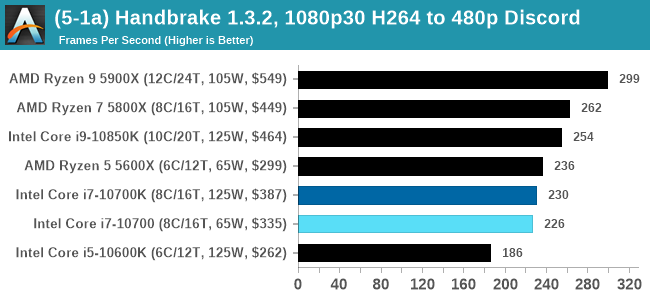

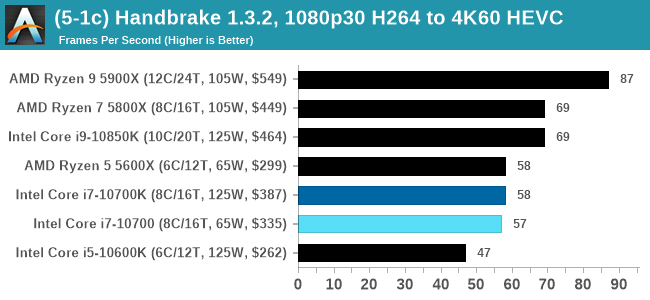
7-Zip 1900: Link
The first compression benchmark tool we use is the open-source 7-zip, which typically offers good scaling across multiple cores. 7-zip is the compression tool most cited by readers as one they would rather see benchmarks on, and the program includes a built-in benchmark tool for both compression and decompression.
The tool can either be run from inside the software or through the command line. We take the latter route as it is easier to automate, obtain results, and put through our process. The command line flags available offer an option for repeated runs, and the output provides the average automatically through the console. We direct this output into a text file and regex the required values for compression, decompression, and a combined score.
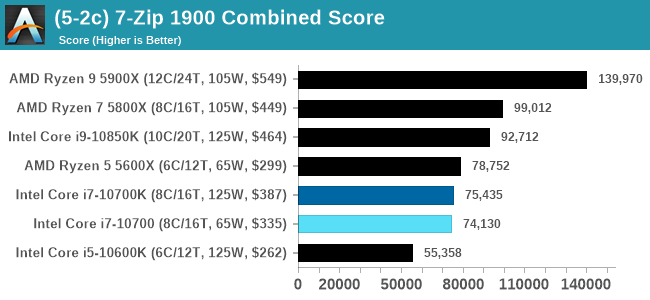
AES Encoding
Algorithms using AES coding have spread far and wide as a ubiquitous tool for encryption. Again, this is another CPU limited test, and modern CPUs have special AES pathways to accelerate their performance. We often see scaling in both frequency and cores with this benchmark. We use the latest version of TrueCrypt and run its benchmark mode over 1GB of in-DRAM data. Results shown are the GB/s average of encryption and decryption.
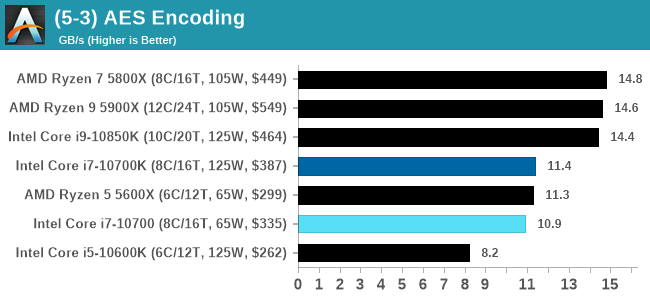
WinRAR 5.90: Link
For the 2020 test suite, we move to the latest version of WinRAR in our compression test. WinRAR in some quarters is more user friendly that 7-Zip, hence its inclusion. Rather than use a benchmark mode as we did with 7-Zip, here we take a set of files representative of a generic stack
- 33 video files , each 30 seconds, in 1.37 GB,
- 2834 smaller website files in 370 folders in 150 MB,
- 100 Beat Saber music tracks and input files, for 451 MB
This is a mixture of compressible and incompressible formats. The results shown are the time taken to encode the file. Due to DRAM caching, we run the test for 20 minutes times and take the average of the last five runs when the benchmark is in a steady state.
For automation, we use AHK’s internal timing tools from initiating the workload until the window closes signifying the end. This means the results are contained within AHK, with an average of the last 5 results being easy enough to calculate.
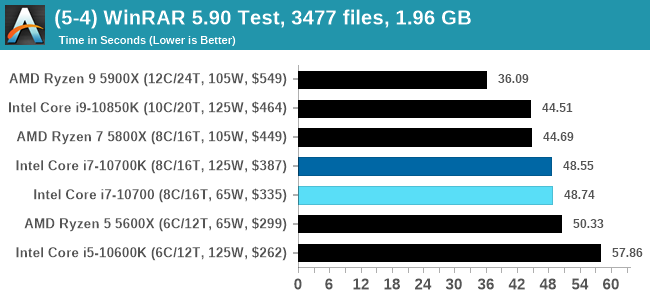


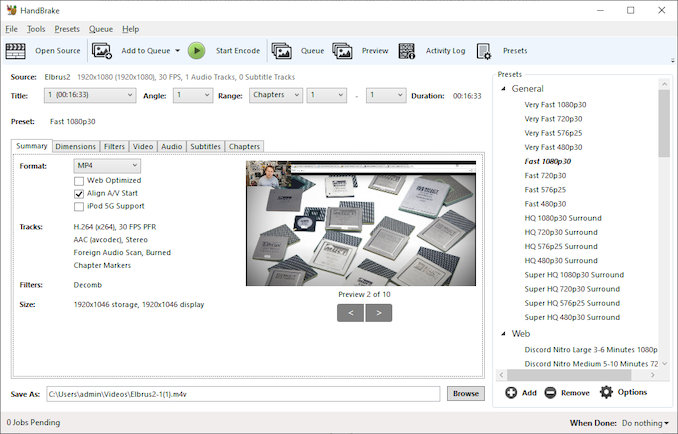
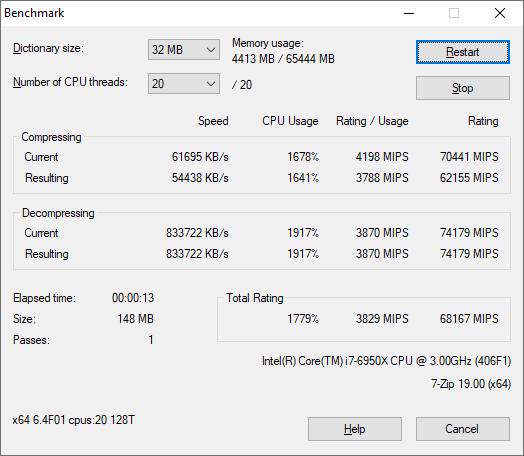









210 Comments
View All Comments
Spunjji - Friday, January 22, 2021 - link
Who's to decide which memory speeds they ought to test with, though? They can't rightly test with all of them, but what's "enough" - 3200, 3600, 4000?The honest truth is you can get info about performance of a specific CPU with varying memory speeds elsewhere. For the few percent difference in performance it actually makes, I personally don't care whether or not they bother, and I've been coming here for well over 15 years now.
Oxford Guy - Friday, January 22, 2021 - link
Who decides? The reviewer. Reviewers are supposed to know where the sweet spot is. It’s not that difficult to figure out.Oxford Guy - Friday, January 22, 2021 - link
It’s also hilarious for Intel to allegedly be worried about ‘RAM’ overclocking but not pushing ‘65W’ CPUs to 215W sustained.I’ll buy that for a dollar!
Spunjji - Monday, January 25, 2021 - link
On this point, we agree. Intel's definition of what does and does not constitute overclocking has become increasingly bizarre.IanCutress - Saturday, January 23, 2021 - link
What? No. A reviewers job is to provide consistent and trackable data that holds the vendor to their claims. What you're looking for is a buyers guide.Oxford Guy - Sunday, January 24, 2021 - link
The data comes from assembling the correct components.Qasar - Sunday, January 24, 2021 - link
which, as Dr Cutress said, is called a buyers guide. this is a review.Oxford Guy - Monday, January 25, 2021 - link
Oh please. A review tells people how the equipment performs. Since Zen 2, for instance, is most efficient at 3600 RAM speed, running it at JEDEC, a standard designed so that el-cheapo boards can support it, is not a good one. It does not tell readers how the equipment maximally performs.Qasar - Tuesday, January 26, 2021 - link
Product reviews show customer experience with a product or brand. It’s where customers give their opinion on what they think about your product, and this can be positive or negative. Positive reviews show the customer was satisfied with the quality of the product, while negative reviews indicate bad experiences.Buying guides, on the other hand, help customers identify the right product to buy. A buyer’s guide includes a product’s specifications, how it compares with other similar products, the benefits, and such. Buying guides provide readers with the necessary information needed to make informed purchasing decisions.
Spunjji - Monday, January 25, 2021 - link
What if I don't agree about the location of the "sweet spot" based on RAM prices local to me, or my own performance needs? Your response isn't the best solution to the problem, it's just a different answer.My preference is for the reviewer to test a CPU at-or-near stock settings, then publish separate articles on things like the returns on faster RAM speeds/timings and overclocking. The minor performance difference from faster RAM really isn't enough to invalidate the review's conclusions.